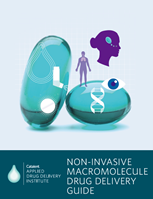LEADERSHIP
Randy Mrsny, Ph.D, University of Bath
Chair of the NMDC
Randall Mrsny obtained a BS degree in Biochemistry and Biophysics and a PhD degree in Anatomy and Cell Biology from the University of California at Davis undergraduate and medical school campuses, respectively. As an NIH post-doctoral fellowship he studies membrane lipid-protein interactions at the Institute of Molecular Biology located in the University of Oregon Eugene campus. Prior to taking Professors’ post in Cardiff University and now the University of Bath, Randy led research groups in two companies: ALZA and Genentech. He has been involved in starting two new biotech companies through the acquisition of venture capital funding. Randy has been elected president of an international society and organized international meeting. He currently serves as a reviewer or advisor for multiple international agencies and companies.
Dr. Edith Mathiowitz, Brown University
Oral Working Group, Academic Co-Chair, NMDC
Dr. Edith Mathiowitz is a full Professor of Medical Science and Engineering at Brown University in the Department of Molecular Pharmacology, Physiology & Biotechnology. She is also the Director of the Biotechnology Graduate Program. Her extensive experience includes development of polymers that are used in drug and gene delivery systems and tissue engineering applications, including stem cell recruitment. Following her undergraduate degree in physical chemistry and graduate school at the Weizmann Institute of Science, Dr. Mathiowitz trained as a postdoctoral associate with Professor Robert Langer.
Claus-Michael Lehr, University of Saarland
Pulmonary/Nasal Working Group, Academic Co-Chair, NMDC
Dr. Claus-Michael Lehr, Professor and Head of the Department of Drug Delivery (DDEL), Saarland University and Advisory Board Member of the Catalent Institute has spent more than 15 years leading research into ways to overcome biological barriers to effective drug delivery, and the development and formulation of appropriate carriers to transport active pharmaceutical and biopharmaceutical molecules to desired targets. He has co-authored many notable publications on the development of sophisticated in-vitro models that more accurately represent the epithelial cells and tissues concerned in transport, and the application of nanotechnology to improve in-vivo delivery to such therapeutic targets.
Dr. Ralph W. Niven, MBA, Novartis
Pulmonary/Nasal Working Group, Industry Co-Chair, NMDC
Dr. Ralph W. Niven, MBA, serves on the site management team of Novartis in San Carlos. He has previously held executive positions within APT Pharmaceuticals, Discovery Labs and Advanced Inhalation Research and started his industrial experience at Amgen developing proteins and peptides suitable for inhalation. Throughout his career he has had an ongoing interest and direct involvement in the development of numerous inhaled products. Ralph is the current treasurer of the International Society for Aerosols in Medicine. He received his PhD from the University of Kentucky and his MBA from George Washington University.
Dr. Bozena Michniak-Kohn, Rutgers University
Transdermal Working Group, Academic Co-Chair, NMDC
Bozena B. Michniak-Kohn is a Professor of Pharmaceutics at the Ernest Mario School of Pharmacy at Rutgers University and is Director of the Center for Dermal Research (CDR) and Michniak Laboratory for Drug Delivery (LDD) of the NJ Center for Biomaterials (NJCBM), as well as Project Leader, FDA Liaison and Steering Committee Member of the $15M NSF Engineering Research Center (ERC). Previously (2000-2005) she was at the Dept. of Pharmacology & Physiology, UMDNJ – NJ Medical School (Newark) & was Director of the Laboratory for Drug Delivery for NJCBM-Newark. She obtained her Ph.D. in Pharmacology in 1980 from Leicester Polytechnic, Leicester, U.K now renamed the DeMontfort University. Postdoctoral experience was gained with Profs. N. Bodor (University of Florida) and B. Barry (University of Bradford, U.K). She returned in 1986 to the U.S. as Assistant Professor, College of Pharmacy, University of South Carolina-USC, Columbia SC. In 1998 she became tenured full Professor and Director of the Transdermal and Topical Drug Delivery Laboratory at USC.
Dr. Justin Hanes, Johns Hopkins University
Ocular Working Group, Academic Co-Chair, NMDC
Dr. Justin Hanes is the Lewis J. Ort Professor and Director of the Center for Nanomedicine at the Johns Hopkins University School of Medicine. He holds faculty appointments in Biomedical Engineering, Chemical & Biomolecular Engineering, Environmental Health Sciences, Neurosurgery, Oncology, and Ophthalmology. He is a founder and former member of the board of directors of Kala Pharmaceuticals, and he is a founder, Chair of the Board of Directors, and former CEO of GrayBug, a company developing advanced drug delivery systems with a focus on the treatment of diseases that affect vision. He also recently co-founded Theraly Pharmaceuticals and Theraly Diabetes. He serves on the scientific advisory board of the Controlled Release Society and has served on the scientific advisory board for Genentech in the Drug Delivery Division. He serves on the editorial boards of ten journals focused primarily and nanotechnology, pharmaceutical science, biomaterials and drug delivery. He is the Chair of the Gene and Drug Delivery study section for the NIH. Justin is a fellow of CRS, AAPS, and the American Institute for Medical and Biological Engineering. He received a B.S. in Chemical Engineering from UCLA in 1991 and Ph.D. in Chemical Engineering from MIT in 1996. He did postdoctoral training in Oncology and Neurosurgery at the Johns Hopkins University School of Medicine in 1996-1998.

